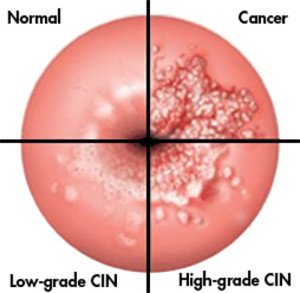Abnormal cells are not cancer. But they can lead to cancer.
You may have heard the terms “dysplasia,” “LSIL,” “HSIL,” “CIN I, CIN II or CIN III,” or “Carcinoma in situ.” You also may have heard the word “pre-cancer.” But try not to be overwhelmed. All of these terms refer to some sort of abnormal cells in your cervix.
Diagnosing Abnormal Cells
- Your healthcare provider performs a colposcopy to look for cell abnormalities. Colposcopy views the cervix with a lighted magnifying instrument to see the abnormal cells more closely.
- If your provider sees abnormal cells, he/she will perform a biopsy to determine if you need treatment for your abnormal cells. Biopsy removes a tissue sample for analysis in the laboratory. The biopsy helps determine if the cell changes are minor or more severe and what further treatment, if any, may be necessary.
Abnormal cells can be called squamous intraepithelial lesions (SIL) or cervical intraepithelial neoplasia (CIN).
- Low-grade SIL (LSIL) or CIN I, meaning mild cell changes.
- High-grade SIL (HSIL), CIN II or CIN III, meaning moderate to severe cell changes.
Many cases of CIN I go away by themselves. Your healthcare provider will often treat CIN II or CIN III.
CIN III can also be referred to as carcinoma in situ or stage 0 pre-invasive cancer. If left untreated, these abnormal cells may spread further into the cervix.
 This picture of a cervix shows the timeline. Moving counterclockwise from Normal, the quarters show low-grade CIN (about one-third of the cells are abnormal), high-grade CIN (almost all cells are abnormal), and full-blown cancer.
This picture of a cervix shows the timeline. Moving counterclockwise from Normal, the quarters show low-grade CIN (about one-third of the cells are abnormal), high-grade CIN (almost all cells are abnormal), and full-blown cancer.
Treating Abnormal Cells
- LEEP (loop electrosurgical excision procedure): A fine wire loop carrying a (safe!) electrical current removes abnormal tissue.
- Laser or “cold-knife” conization (cone biopsy): A laser or scalpel (“cold-knife”) removes a cone or cylinder-shaped piece of the cervix.
- Laser therapy: A tiny beam of high-intensity light vaporizes abnormal cells.
- Cryotherapy: A very cold probe freezes – and destroys – abnormal cells.